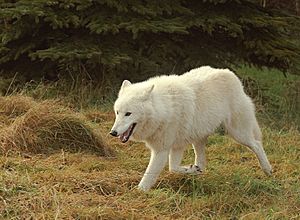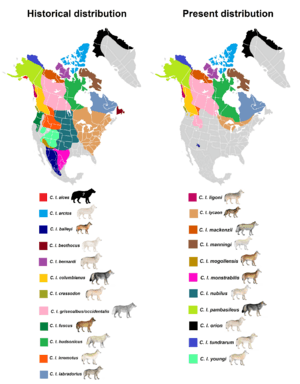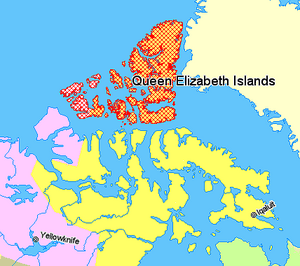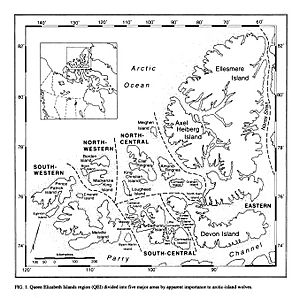Arctic wolf facts for kids
Quick facts for kids Arctic wolf |
|
|---|---|
 |
|
| Scientific classification |
|
| Kingdom: | Animalia |
| Phylum: | Chordata |
| Class: | Mammalia |
| Order: | Carnivora |
| Family: | Canidae |
| Genus: | Canis |
| Species: | |
| Subspecies: |
C. l. arctos
|
| Trinomial name | |
| Canis lupus arctos Pocock, 1935
|
|
 |
|
| Historical and present range of grey wolf subspecies in North America | |
The Arctic wolf (Canis lupus arctos) is also called the white wolf or polar wolf. It is a type of grey wolf that lives in the very cold High Arctic tundra of Canada. You can find them on islands like Melville Island and Ellesmere Island in the Queen Elizabeth Islands.
Unlike some other wolves, Arctic wolves stay north of the treeline their whole lives. This means they live in areas with no trees. Their home range goes as far south as the northern parts of Prince of Wales and Somerset Islands. Arctic wolves are medium-sized. They are smaller than the northwestern wolf and have whiter fur. Scientists think that Arctic wolves might have mixed with dogs over time. This could be why their skulls have become a bit smaller since the 1930s.
Contents
About the Arctic Wolf Name
In 1935, a British scientist named Reginald Pocock gave the Arctic wolf its scientific name, Canis lupus arctos. He studied a wolf from Melville Island in Canada's Queen Elizabeth Islands. He also noted that similar wolves lived on Ellesmere Island.
Pocock also named the Greenland wolf Canis lupus orion. This wolf was from Cape York in northwest Greenland. Both the Arctic wolf and the Greenland wolf are recognized as different types of grey wolves. This recognition comes from a scientific book called Mammal Species of the World (2005).
Some studies using DNA have suggested that Arctic wolves might not be a separate subspecies. This is because their DNA is very similar to wolves from mainland North America. This could mean they moved to the Arctic islands more recently. However, other scientists believe that even if DNA is similar, wolves can still be different subspecies. They think that the habitat where a wolf lives can be enough to tell subspecies apart.
Arctic Wolf Behavior
Arctic wolves are often not very scared of people. In some places, they might even come close to humans. Wolves on Ellesmere Island do not fear humans much. This is probably because they don't see people very often. They might approach people carefully and out of curiosity.
An explorer named Otto Sverdrup wrote about his trip. He said that two wolves followed one of his teammates. The teammate kept them away by waving his ski pole. In 1977, six wolves approached two scientists on Ellesmere Island. One wolf even jumped at a scientist, lightly touching their cheek.
There have been a few cases where wolves became aggressive in Alert, Nunavut. This is a place where wolves have lived near a weather station for many years. They became very used to people there. In one case, a wolf that had become very used to people attacked three individuals. It was later found to have rabies.
Scientists don't know much about how Arctic wolves move around. This is mainly because of the extreme cold and darkness. They only migrate during the winter when it's dark for 24 hours a day. This makes it very hard to study their movements.
One study took place far south of the High Arctic. It was winter, completely dark, and the temperature was as low as -53 degrees Celsius. Researchers found that these wolves mostly hunt muskoxen. But there isn't much information about how the wolves move when they are hunting muskoxen.
What Arctic Wolves Eat
In the wild, Arctic wolves mainly hunt muskoxen and Arctic hares. They also eat lemmings, caribou, Arctic foxes, birds, and even beetles. Sometimes, Arctic wolves will also look for food in garbage. However, this type of food is not always available.
Scientists sometimes debate whether muskoxen or Arctic hares are the main food source. Studies show that muskoxen are likely their primary prey. This is because more wolves and wolf pups are found when there are more muskoxen. Muskoxen seem to provide a steady food source for wolves.
Other studies suggest that wolves depend more on hares. They found that the number of adult wolves increased when there were more hares. The amount of each food source that wolves eat can change with the season and the year.
When it comes to young wolf pups, muskox calves are an important food source. This is because pups need a lot of food to grow. However, some studies show that when hares are plentiful, wolves often feed them to their pups in the summer. These differences might depend on where the wolves live.
Arctic wolves rarely meet Polar bears. But there are two known cases where a wolf pack killed polar bear cubs.
Conservation Status
The Arctic wolf is listed as "least concern" for its survival. This means their population is not currently in great danger. However, they still face some threats.
In 1997, the number of Arctic wolves, muskoxen, and Arctic hares went down. This happened because of bad weather during the summers for four years. Luckily, Arctic wolf populations recovered the next summer when the weather got better.
See also
 In Spanish: Lobo ártico para niños
In Spanish: Lobo ártico para niños



